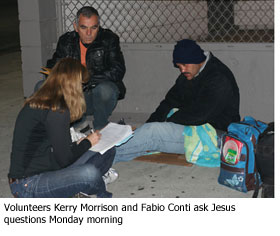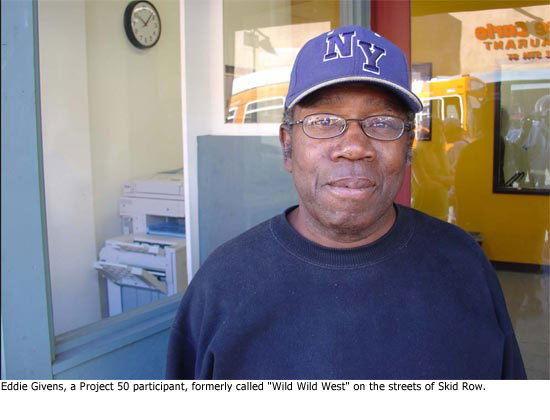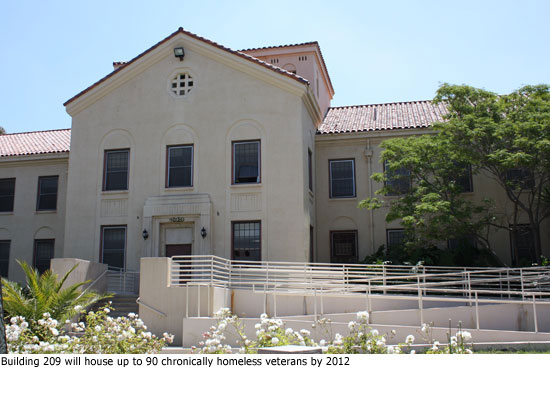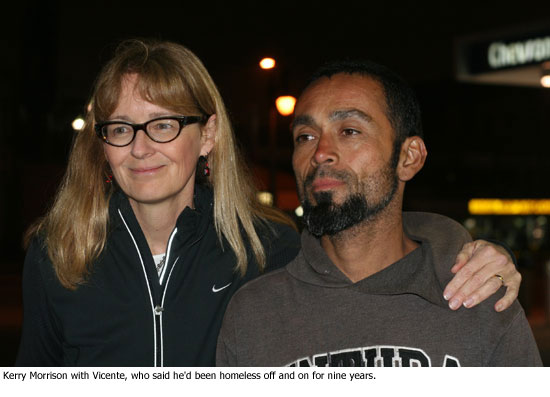Homelessness
Not because it’s easy
August 3, 2010
Philosophical arguments for—and against—an innovative initiative to combat homelessness surfaced Tuesday as Project 50’s most passionate proponent on the Board of Supervisors exchanged views with its leading skeptic.
Their comments came in response to the Los Angeles Times’ four-part series on Project 50, which began in late 2007 and has provided housing to those deemed likeliest to die on Skid Row. It has done so without requiring participants to agree in advance to treatment for substance abuse and other problems, although clients are continually pressured to avail themselves of a range of medical, psychological and drug treatment services once they enter the program. So far, 100% of those who have been housed have received at least one of those services.
Tuesday’s debate turned on the question of housing people without first requiring that they give up drugs.
Supervisor Michael D. Antonovich, a longtime critic of Project 50, spoke first, followed by Supervisor Zev Yaroslavsky, the program’s sponsor and most vocal supporter on the board.
Here is a summary of what each supervisor had to say:
Antonovich started by reading from the newspaper’s first installment, which offered a range of anecdotes about the program’s successes and failures, and ended with an account of the difficulties one long-time drug user was experiencing. It centered on a woman who was beset with “psychological triggers everywhere,” including the smell of crack cocaine vapors as she tried to resist temptation. At one point, she tried to turn her money over to a program official so she would be unable to purchase the drugs that were tempting her. But the official explained she could not legally take her money, and instead helplessly watched as the woman went in search of drugs. “Was it possible to keep people under a roof, even if their addictions and mental illness remained untreated?” Antonovich read, quoting from the article.
Antonovich then reprised some of the questions he had asked when Project 50 came before the board in 2008. He said that assurances he had received then were being proven wrong by the latest quarterly report from Project 50, which he said indicated that “two years into the demonstration, half of the residents with a history of substance abuse are not being treated, which is warehousing without healing.”
He asked Chief Executive Officer William T Fujioka to report back in 14 days on “prohibitions currently in place against Project 50 residents continuing to abuse substances while being housed at taxpayers’ expense.”
Then it was Supervisor Yaroslavsky’s turn.
“I think everyone within the sound of my voice should understand a few things about this program,” Yaroslavsky said. “No. 1, nobody was required as a prerequisite of entering the program [to submit] to a substance abuse test or treatment or see a shrink or do any of the other things as a precondition of entering the program. This is what is revolutionary about this program…If you take the 50 most vulnerable…people on Skid Row or anywhere else in the county and say, ‘Hey, we’ve got a unit for you but we want you to go see a psychiatrist first,’ he’ll tell you to take a walk. That’s been the experience.”
Yaroslavsky noted that the participants “were the 62 most chronically homeless people on the streets of downtown Los Angeles at the time they were selected.” He added that “100% of the people who were part of this program got [at least one kind of] treatment—100%. If we had not done this program, none of them would have gotten treatment. They would still be living on the street. And many of them would be dead.”
He said he was reminded of “President Kennedy’s comment when he launched the project to the moon, where he said, ‘We choose to go to the moon not because it is easy but because it is hard.’ This county chose to do Project 50 not because it was easy but because it was hard.”
He concluded by praising Fujioka and others involved in getting Project 50 launched for “having the courage to risk failure.”
“That’s what we don’t do enough of in the public sector…When you try something different, you risk failure. And nobody wants to be associated with a failure. This is not a failure. This is a success—a risk worth taking.”
To date, 84% of the Project 50 participants are still being housed.
Read Zev’s blog on Project 50 here.
New funds for Westside homeless agencies
July 13, 2010
Federal housing officials last week awarded more than $4.7 million in housing subsidies to three Third District non-profits that are developing cutting edge programs to house the chronically homeless.
The winners of the competitive “Shelter Plus Care” grants were the Venice Community Housing Corporation, Step Up on Second and Ocean Park Community Center, or OPCC.
The grants from the federal Department of Housing and Urban Department provide apartment rental subsidies, or vouchers, for a five-year period. To qualify, the providers must match the value of the vouchers with spending on health care, case management or other services.
All three winning organizations are committed to the concept of permanent supportive housing—combining long term residences with customized health care and social services for homeless people with the greatest risk of dying on the streets. In Los Angeles County, this approach is the hallmark of the successful Project 50 on Skid Row. Since then, programs based on Project 50 have spread to Santa Monica, Venice, Long Beach, West Hollywood and Van Nuys.
“People are homeless because they have underlying problems that, if not addressed, will keep them homeless,” says Howard Katz, a commissioner with the Los Angeles Homeless Services Authority, which will distribute the new funding. “These three organizations have shown that they understand this relationship and know how to effectively address it.”
In addition to the three grants to non-profits, the City of West Hollywood received $1.25 million and the County’s Department of Mental Health $4.13 million in Shelter Plus Care funding.
Here’s how executives of the Third District non-profits say their organizations—and their homeless clients—will benefit from the infusion of rental subsidies:
 Steve Clare, executive director of the Venice Community Housing Corporation, which provides housing and services to low income individuals. The organization received $1,133,220.
Steve Clare, executive director of the Venice Community Housing Corporation, which provides housing and services to low income individuals. The organization received $1,133,220.
“That money will allow us to house 20 homeless people with disabilities who have essentially no income. They’ll live at a new project of ours. It’s called Horizon Apartments, and it’s a 20-unit building we’re renovating that’s located a half block from the beach. It’s a beautiful building; it used to be a short-term tourist hotel and it needs relatively little renovation. We hope we’ll have the building ready next winter. The residents will receive case management and other services, and we’ve contracted to provide mental-health services. We have the building and the services lined up, but the rental subsidy this grant provides is critical. Without it, we’d have to be charging residents $800 or $900 a month per person to cover our basic operating costs. The project would be impossible.”
 John Maceri , executive director of OPCC, a Westside provider that operates shelters and “housing first” programs for the chronically homeless. The organization received $1,659,900.
John Maceri , executive director of OPCC, a Westside provider that operates shelters and “housing first” programs for the chronically homeless. The organization received $1,659,900.
“The award is for 40 vouchers and it’s an enormous boost to our ability to house people. It allows us to continue to expand our services to more of the at-risk homeless who have the most to lose by remaining on the street. Ours is a scatter-site application, meaning that we find apartments for clients all over the area, not in a particular building. We already have about 300 units now. We’ll be working with chronically homeless single adults living with multiple disabilities, from mental health to substance abuse issues and chronic health problems. About 35 percent of the folks we serve are seniors. The length of time on the street ranges from six to 30 years, with the average at 12 years. We have staff who will be intensely involved helping the new clients locate units. I hope we’ll have a start date in the fall.”
 Tod Lipka, chief executive of Step Up on Second, a Santa Monica mental health provider, which is launching a new Step Up on Vine project in Hollywood. The organization received $1,980,300.
Tod Lipka, chief executive of Step Up on Second, a Santa Monica mental health provider, which is launching a new Step Up on Vine project in Hollywood. The organization received $1,980,300.
“We’re converting a three story motel on Vine Street into a 34-unit permanent supportive housing facility for homeless people living on the streets of Hollywood. We acquired the building in August 2009 for $3 million. Our timetable is to begin construction in June 2011 and open in June 2012. We’ll be housing chronically homeless people with mental health disabilities. It’s typically schizophrenia, bipolar disorder or major depression. All of these people will be very low income. The vouchers…are really necessary to cover the gap between the small amounts the residents can pay, which is 30 percent of their income, and the actual operating costs. We’re going to provide ongoing support because housing is a big transition for people who have lived on the streets long-term. As one of our clients said, ‘Getting housing is just the first step’.”
Posted 7/13/10
Empty VA building to house homeless vets
June 28, 2010
Vacant for nearly two decades, Building 209 on the Veterans Administration’s sprawling West L.A. property was a one-time mental health ward without a modern mission.
But thanks to $20 million pledged by Department of Veterans Affairs Secretary Eric Shinseki, the three-story, 46,000 square foot facility will get a top-to-bottom renovation and provide chronically-homeless veterans with a new home.
“Ending Veteran homelessness is one of my top priorities, and this building renovation will provide housing and take us one stop closer to achieving our goal,” Shinseki said, referring to a plan he announced last fall to end veterans’ homelessness by 2015. “No veteran should have to face the challenge of being homeless.”
Building 209 will be converted into apartments for 70 to 90 veterans who have long-standing problems with homelessness. The facility will provide not only housing, but also therapeutic services that include medical and mental health care treatment. In Los Angeles County, there are an estimated 6,540 homeless veterans.
The stucco building, built in 1945, was first used as an in-patient psychiatric facility and was later converted for out-patient care. It’s been empty since the early 1990s.
The promise of funding came during a June 16 meeting on Capitol Hill between Shinseki, Sen. Dianne Feinstein, Rep. Henry Waxman and L.A. County Supervisor Zev Yaroslavsky. At the hour-long meeting, held in Feinstein’s office, Shinseki also promised to help the officials find additional funding to convert two adjacent buildings to provide similar housing.
“I’m very encouraged by Secretary Shinseki’s pledge of $20 million to make this renovation project a reality,” Feinstein said in a joint statement with Waxman and Yaroslavsky.
“We so appreciate Secretary Shinseki’s commitment to house our homeless veterans who have already sacrificed so much for our nation,” Yaroslavsky said.
“This action will provide critical long-term therapeutic housing that is long overdue,” Waxman said.
The deal caps an arduous 6-year effort that began in 2004 after Santa Monica Mayor Bobby Shriver, then running for city council, proposed housing the homeless in empty buildings at the VA’s facility.
At the time, the Bush Administration was considering selling portions of the Veterans Administration land, including the property around Building 209, to private developers. The privatization effort failed, and Shriver and other elected officials pushed successfully to have the three buildings set aside for homeless services. In 2007, then-Veterans Affairs Secretary James Nicholson agreed to the plan.
Still, the buildings sat vacant, partly because of a failed effort by VA officials to secure funding from the non-profit sector. Last winter, Feinstein, Waxman and Yaroslavksy pushed the VA to come up with an alternative plan to fund the renovation.
Shinseki’s $20 million pledge will cover seismic retrofitting and a top to bottom overhaul.
“It’ll basically be gutting the whole darned building and redoing it,” said Ronald Norby, director of the VA Desert Pacific Healthcare Network, which covers Southern California and Southern Nevada.
The facility will be the first at the West L.A. facility to provide long-term housing plus therapeutic services for the most difficult to reach veterans, some of whom have been on the street for years.
Additional federal money will be needed to operate the facility, which could be run either by VA staffers or by a non-profit contract provider, according to VA officials.
In a statement Monday, Shriver said the Veterans Administration’s commitment was “fantastic news.” But he added: “We won’t say congratulations until the first homeless veteran is housed and receiving treatment.”
Embracing the Hollywood homeless
April 29, 2010
“I’m Kerry, what’s your name?”
It’s 4:30 a.m. on Monday, and Kerry Morrison, a Hancock Park mother of two teens, stops a limping man named Vicente at a Chevron station on Highland Avenue in Hollywood. The tall woman with the clipboard is calm, friendly and matter of fact.
“I want to ask you some questions about being homeless.”
With a bit of sweet talk—and a free meal card from Subway—Morrison cajoles Vicente to share his saga of street life, which includes frostbite, substance abuse and jail time.
“I’m so happy that this is finally happening,” Morrison says walking down Hollywood Boulevard after speaking to Vicente. “We need to do everything we can to humanize the homeless.”
Morrison is one of more than 50 volunteers collecting data for the Hollywood Homeless Registry, a three-night survey that marks the first detailed study of the full homeless population in that area.
She’s also the driving force behind the whole effort.
Morrison, 54, is executive director of the Hollywood Entertainment Business Improvement District, a band of 250 business owners working to improve economic and quality of life conditions on Hollywood Boulevard. She’s worked for more than two years to bring together non-profits, government and business groups in a coalition called Hollywood 4WRD to help end the neighborhood’s longstanding homeless problem.
“Kerry’s been the hub,” says Fabio Conti, owner of Fabiolus Café on Sunset Boulevard who brought jackets and blankets to hand out to the homeless. “She’s the happiest lady in the world when she’s talking to these people.”
Beth Sandor, field director in Los Angeles for Common Ground, a homeless advocacy group that developed the four-page “vulnerability index” questionnaire used in the survey, praised Morrison as “one of the most committed business leaders in Los Angeles on the issue of ending homelessness.”
The purpose of Common Ground’s 38-question survey is to identify those most likely to die on the streets and provide them with housing and comprehensive medical, mental health and social services. The questions focus on factors such as the number of recent emergency-room visits, jail stints, substance abuse problems and chronic illnesses.
The vulnerability index was instrumental in the creation of Project 50, the groundbreaking program launched more than two years ago at the urging of Supervisor Zev Yaroslavsky that has housed and provided services for 66 once-chronically homeless individuals on L.A.’s Skid Row. That program has now been replicated in other parts of Yaroslavsky’s district, including Venice, Santa Monica and Van Nuys.
 Before the pre-dawn launch of the Hollywood effort, the supervisor spoke to the survey volunteers and then headed onto the streets with them. By Wednesday afternoon, questionnaires had been completed for 257 homeless men. Another 70 declined to participate. More than 82 percent of the Hollywood homeless were men, whose ages ranged from late teens to a newly-homeless man of 80.
Before the pre-dawn launch of the Hollywood effort, the supervisor spoke to the survey volunteers and then headed onto the streets with them. By Wednesday afternoon, questionnaires had been completed for 257 homeless men. Another 70 declined to participate. More than 82 percent of the Hollywood homeless were men, whose ages ranged from late teens to a newly-homeless man of 80.
Morrison once seemed like an unlikely champion for Hollywood’s homeless. Raised in a middle-class Denver suburb, the daughter of a steel salesman, Morrison worked in government affairs at the California Association of Realtors for over a decade after moving to L.A. in the late 1970s.
Jolted by the 1992 riots to aid in the city’s recovery, she became executive director of the new Hollywood business improvement district, and came face to face with the neighborhood’s homeless problem.
As Hollywood worked to gentrify, some business owners—and many residents—hoped the solution to the homeless problem was simply to move the street people out. Morrison disagreed and vowed to educate herself and her board members.
She came to prefer the “permanent supportive housing” model, in which individuals are given apartments along with a variety of services to help them lead more stable and healthy lives. Her view was far from prevalent. When a 60-unit project was proposed for Gower Avenue in 2006, the backlash stunned Morrison.
“The community vitriol was mind-boggling,” she recalls. To this day, the project remains on hold.
In 2008, Morrison invited then-President Bush’s homeless czar, Philip Mangano, to make the case for permanent supportive housing as a better solution than shelters for the urban homeless. Later, she organized a field trip to visit Step Up on Second’s permanent supportive housing facility in Santa Monica. She put together a “snapshot” count of Hollywood’s homeless that year that found about 500 people living on the streets.
As part of her education, Morrison also realized she needed to get closer to her homeless neighbors. “I made a commitment to start talking to homeless people,” she recalls. “I had to conquer my own fears.”
She befriended local street people, including a mentally-ill man named Torrey who slept along the Walk of Fame until Morrison pushed for his hospitalization. He now lives in a Hollywood motel, although he declines to take his medication, Morrison says.
The experience taught her that it was essential for business owners and the public to see the homeless as people with individual stories.
That’s why the Hollywood team will take the unusual step of announcing the names and profiles of the 10 most vulnerable among Hollywood’s homeless at a news conference at 2 p.m. Friday at the Los Angeles Film School, 6353 Sunset Boulevard.
“We know that getting housing for them won’t happen unless we put the names and faces to the issue,” Morrison says.
The problem, Morrison notes, is that there aren’t yet apartments and housing in place for these individuals. Step Up on Second has bought a motel on Vine Street for permanent supportive homeless housing, but construction has yet to get underway. A committee is working to identify other housing possibilities, Morrison says.
She hopes publicity from the survey will lead to housing breakthroughs. She notes happily that Los Angeles City Councilman Tom LaBonge and two staffers joined the survey Tuesday morning and hopes he and other city leaders will come through with help on the housing front.
“The survey is an essential step,” says Morrison. “I’m incredibly optimistic that Hollywood can be a community that can embrace the homeless.”
Posted 4-29-10
Read related story
On his blog, Zev writes about his night with the Hollywood homeless.
Project 50: watch us grow
October 15, 2009
Call it “Project 250.”
Spurred by the success of Project 50, the paradigm-busting homeless program targeting Skid Row’s most vulnerable residents, Supervisor Zev Yaroslavsky earlier this year proposed a countywide expansion he dubbed Project 500. But when the full Board of Supervisors asked the Auditor Controller to further study the program’s benefits before committing, many observers guessed that the expansion was on hold.
Not exactly.
Without fanfare, similar county-approved homelessness projects in three Third District communities are already well underway, working to house 130 in Santa Monica, 40 in Venice and 30 more in Van Nuys. Together with the initial 50 clients in downtown L.A., you might say Project 500 is halfway home.
The newer projects follow similar protocols pioneered in downtown Los Angeles by Project 50, an innovative initiative shepherded through the board by Yaroslavsky that is now in its second year.
Outreach workers identify the most at-risk homeless based on a “vulnerability index” created by New York City-based homeless advocates Common Ground. The index assesses such factors as recent hospitalizations, arrests, addiction issues and length of homelessness. Those in gravest danger of death are placed in permanent supportive housing, surrounded with health and mental health services, along with substance abuse treatment, that can revitalize lives and save taxpayer’s money in reduced jail time, hospital stays and emergency room visits.
During its first year, Project 50 reported encouraging results (see Power Point here). Among other things, those results suggested that the chronically homeless are not “service-resistant” and want to move into housing. Eighty-eight percent of the men and women recruited at the beginning of the program remained in housing at the end of the year, despite the fact that they’d averaged nearly 10 full years living on the streets before signing up. Thirty seven of the 39 in the group diagnosed with mental illness were receiving treatment, and 61 percent of the substance abusers had entered counseling.
Preliminary cost data showed substantial savings, too. Hospital and emergency room visits plunged for the group compared to the previous year, as did jail time, saving taxpayers more than $500,000, according to preliminary figures. Project 50 has been allocated $3.6 million in county funding.
The new programs:
Venice: St. Joseph Center of Venice, which identified the community’s most vulnerable homeless individuals during a three-night survey in May, has signed up 28 of the 40 clients it hopes to house in its two-year program, according to Va Lecia Adams, the center’s executive director. One of those is Gigi Davis, 51, a Marine Corps vet who has been sleeping on the streets near the Venice post office and says she is bipolar and has a drinking problem. Now taking psychiatric medications, she says she is grateful “for the improvement in my day to day life that I’m already seeing.”
Santa Monica: Five providers are combining to house 130 of the area’s most vulnerable homeless people, first identified in a survey nearly two years ago. The Ocean Park Community Center is serving 40 individuals, and Step Up on Second is working with 30. The other clients are working with the Clare Foundation, St. Joseph Center and the Veterans Administration. Tod Lipka, Step Up on Second’s CEO, noted that a recent homeless census showed a first-ever drop in this population, boosting confidence that homelessness can be successfully attacked. Such programs, Lipka, says go “a long way to address the problems of homelessness.”
Van Nuys: Following a homeless survey in May in Van Nuys, the San Fernando Valley Community Mental Health Center will be combining services for 30 clients over the next year. Program director Anita Kaplan says 13 clients have been enrolled and will get Section 8 housing vouchers as they become available. “This fast-track into permanent housing is definitely unique,” says Kaplan. “I do see a lot of successes.”
Read L.A. Times columnist Steve Lopez’s take on Project 50.
Posted 10/15/09
















 405 bridge work causes a stink
405 bridge work causes a stink

